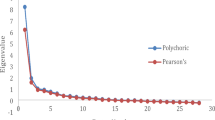Abstract
Innovative research is constrained by instruments that assume gender to be captured by dichotomous categories. This article presents the results of two studies that document the psychometric properties of the Social Roles Questionnaire (SRQ), a new measure of gender role attitudes. A social constructivist perspective guided the development of the instrument that was designed not only to capture the diversity in people’s thinking about social roles for men and women, but also to identify attitudes that transcend binary categories. The article details the process of assessing reliability and validity based on data from 414 undergraduates. Findings revealed the SRQ is reliable and valid and that women were more likely than men to endorse egalitarian and gender transcendent beliefs. Additional possible uses of the SRQ are discussed.
Similar content being viewed by others
References
Antill, J. K., Cotton, S., Goodnow, J. J., & Russell, G. (1996). Measures of children’s sex typing in middle childhood II. Australian Journal of Psychology, 48, 35–44.
Baber, K. M., & Monahan, P. (1988). College women’s career and motherhood expectations: New options, old dilemmas. Sex Roles, 19, 189–203.
Bockting, W. O. (1999). From construction to context: Gender through the eyes of the transgendered. SIECUS Report, 28, 3–7.
Bohan, J. S. (2002). Sex differences and/in the self: Classic themes, feminist variations, postmodern challenges. Psychology of Women Quarterly, 26, 74–88.
Butler, J. (1990). Gender trouble: Feminism and the subversion of identity. New York: Routledge.
Connell, R. W. (2000). Masculinities and globalization. In M. Baca Zinn, P. Hondagneu-Sotelo, & M. A. Messner (Eds.), Gender through the prism of difference (pp. 49–62). Boston: Allyn & Bacon.
Crowne, D. P., & Marlowe, D. (1960). A new scale of social desirability independent of psychopathology. Journal of Consulting Psychology, 24, 349–354.
Crowne, D. P., & Marlowe, D. (1964). The approval motive: Studies in evaluative dependence. New York: Wiley.
Gordon, L. E., & Abbott, S. A. (2003). The social constructionist’s “essential” guide to sex. In R. Heasley & B. Crane (Eds.), Sexual lives (pp. 28–39). Boston: McGraw-Hill.
Harding, J. (1998). Sex acts: Practices of femininity and masculinity. Thousand Oaks, CA: Sage.
Hoffman, L. W., & Kloska, D. D. (1995). Parents’ gender-based attitudes toward marital roles and child rearing: Development and validation of new measures. Sex Roles, 32, 273–295.
Huston, A. C. (1983). Sex typing. In E. M. Hetherington & P. H. Mussen (Eds.), Handbook of child psychology: Socialization, personality, and social behavior (Vol. 4, pp. 387–467). New York: Wiley.
Hy, L. X., & Loevinger, J. (1996). Measuring ego development (2nd ed.). Mahwah, NJ: Erlbaum.
Kessler, S., & McKenna, W. (2003). Who put the “trans” in transgender?: Gender theory and everyday life. In S. LaFont (Ed.), Constructing sexualities:Readings in sexuality, gender, and culture (pp. 223–236). Upper Saddle River, NJ: Prentice-Hall.
Kimmel, M. S. (2000). The gendered society. New York: Oxford University Press.
King, L. A., & King, D. W. (1997). Sex-role Egalitarianism Scale: Development, psychometric properties, and recommendations for future research. Psychology of Women Quarterly, 21, 71–87.
Kirsch, M. H. (2000). Queer theory and social change. New York: Routledge.
Lorber, J. (2001). Gender inequality: Feminist theories and politics. Los Angeles: Roxbury.
Maurer, L. (1999). Transgressing sex and gender: Deconstruction zone ahead? SIECUS Report, 28, 14–21.
Nunnally, J. (1978). Psychometric theory (2nd ed.). New York: McGraw-Hill.
Patten, M. L. (1997). Understanding research methods. Los Angeles: Pyrczak.
Pedhazur, E. J., & Schmelkin, L. P. (1991). Measurement, design, and analysis: An integrated approach. Hillsdale, NJ: Erlbaum.
Ruble, D. N., & Martin, C. L. (1998). Gender development. In W. Damon & N. Eisenberg (Eds.), Handbook of child psychology: Vol. 3. Social, emotional, and personality (5th ed., pp. 933–1016). New York: Wiley.
Spence, J. T. (1993). Gender-related traits and gender ideology: Evidence for multifactorial theory. Journal of Personality and Social Psychology, 64, 624–635.
Spence, J. T., & Helmreich, R. I. (1978). Masculinity and femininity: Their psychological dimensions, correlates, and antecedents. Austin, TX: University of Texas Press.
Spence, J. T., Helmreich, R., & Stapp, J. (1973). A short version of the Attitudes Toward Women Scale (AWS). Bulletin of the Psychonomic Society, 2, 219–220.
Swim, J. K., Aikin, K. J., Hall, W. S., & Hunter, B. A. (1995). Sexism and racism: Old fashioned and modern prejudices. Journal of Personality and Social Psychology, 68, 199–214.
Swim, J. K., & Cohen, L. L. (1997). Overt, covert, and subtle sexism: A comparison between the Attitudes toward Women and Modern Sexism scales. Psychology of Women Quarterly, 21, 103–118.
Thompson, E. H., Pleck, J. H., & Ferrera, D. L. (1992). Men and masculinities: Scales for masculinity ideology and masculinity-related constructs. Sex Roles, 27, 573–607.
Twenge, J. M. (1997). Attitudes toward women 1970–1995: A meta-analysis. Psychology of Women Quarterly, 21, 35–51.
West, C., & Zimmerman, D. (1987). Doing gender. Gender and Society, 1, 125–151.
Acknowledgments
This research was funded in part by a Graduate School Summer Faculty Fellowship and by the Vice President of Research’s Discretionary Fund at the University of New Hampshire to the second author. We thank Elisa Hankenson, Rod Kovach, Karolynn Mandalone, Stacey Pieczarka, Danielle Pupa, and Elizabeth Ryan for their help in conducting this investigation. Partial results of these studies were presented at the meetings of the National Council on Family Relations, Rochester, NY, November 2001, and Houston, TX, November 2002. Both authors contributed equally to the study.
Author information
Authors and Affiliations
Corresponding author
Rights and permissions
About this article
Cite this article
Baber, K.M., Tucker, C.J. The Social Roles Questionnaire: A New Approach to Measuring Attitudes Toward Gender. Sex Roles 54, 459–467 (2006). https://doi.org/10.1007/s11199-006-9018-y
Published:
Issue Date:
DOI: https://doi.org/10.1007/s11199-006-9018-y




